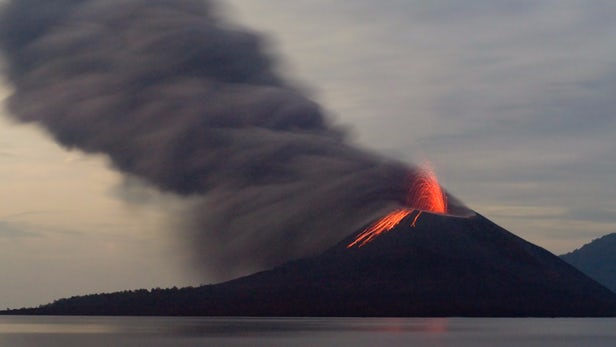Ancient global warming event linked to volcanic CO2

Evidence has been uncovered linking volcanic eruptions to one of the most rapid periods of global warming in Earth's history (Credit: Byelikova/Depositphotos)
We're currently breaking climate record after climate record, and it appears that we might be on track to topple a record that's held strong for about 56 million years. The Palaeocene-Eocene Thermal Maximum (PETM) was the most rapid and extreme example of global warming since the dinosaurs were wiped out, and a new study has found evidence that intense volcanic eruptions were to blame, pumping mind-boggling amounts of carbon into the oceans and atmosphere.
About 10 million years into the current period, the Cenozoic Era, the Earth went through a relatively rapid warming phase, which lasted for about 150,000 years and spiked global temperatures by an extra 5° C (9° F). Evidence in the geological record points the finger at excess carbon as the cause of the PETM – that much has been known for a while, but debate has raged regarding just where all that carbon initially came from and how much was added to the oceans and atmosphere.
The formation of flood basalts, huge swathes of the seafloor in the North Atlantic that were covered in lava, was an almost literal smoking gun. These formed suspiciously close in time to the PETM climate event, but direct evidence linking the two hadn't been detected.
To try to uncover that evidence, a new study led by researchers at the University of Southampton first looked at fossilized plankton called foraminifera. The chemical makeup of the shells of these organisms acts like a time capsule of the environmental conditions they lived in, as changes in the isotopes in their shells paints a picture of the changing pH levels of the ocean. That in turn helps the team pin down where that CO2 came from, and how much there was.
"Ocean pH tells us about the amount of carbon absorbed by ancient seawater, but we can get even more information by also considering changes in the isotopes of carbon, as these provide an indication of its source," says Andy Ridgwell, co-author of the study. "When we force a numerical global climate model to take into account both sets of changes, the results point to the large-scale volcanism associated with the opening of the North Atlantic as the primary driver of the PETM."
As it turns out, an absolutely massive 10,000 petagrams (1 petagram is a trillion kilograms) of carbon was released at that time. For reference, this is about 30 times more carbon than all fossil fuels humanity has ever burned to date, and according to the researchers, it increased the atmospheric CO2 concentration from 800 parts per million to more than 2,000 ppm.
For reference, our current CO2 concentration sits at just over 400 ppm, but as humanity tends to do, we're currently full steam ahead towards surpassing 2,000 ppm in the next few centuries. We're adding carbon to the atmosphere 20 times faster than the eruptions in the PETM, so studying how the Earth bounced back from those devastating spikes could be key to understanding what to expect in the future.
"One unexpected result of our study was that enhanced organic matter burial was important in ultimately drawing down the released carbon out of the atmosphere and ocean and thereby accelerating the recovery of the Earth system," says Philip Sexton, co-author of the study. "This shows the real value of studying these ancient warming events as they provide really valuable insights into how Earth behaves when its climate system and carbon cycle are dramatically perturbed."
The research was published in the journal Nature.
Source: University of Southampton
